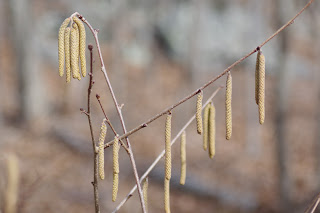Ah, spring flowers...
Not what you had in mind? Well, aside from one creeping myrtle bloom, this is what I've got. These are male hazelnut flowers. Or catkins. If you have pollen allergies, it's not the showy, beautiful flowers that are your problem, no, those are pollinated by bees, and they have heavy, sticky pollen. What you have to worry about are male flowers that look pretty much like this. I accidentally bumped one and a cloud of pollen was released. Fortunately, I was upwind. My allergy shots don't contain hazelnut pollen. I don't know if I am allergic to hazelnut pollen, they don't test for that, but I am allergic to a lot of other tree pollens. Best to avoid breathing it in. The female flowers of the hazelnut tree are tiny and unremarkable... and I couldn't find any on either of my hazelnut trees. I hope they are there, and I am just not seeing them, because without the female flowers there will be no hazelnuts.
I did a partial bug walk in my backyard today–it was irresistible, because the temperature was in the mid-60s and it was gloriously sunny. Imagine my disappointment that this is the only bug I saw:
Springtail, I think.
Better look. It was scurrying along on this tree trunk. I spotted it while trying to take a picture of the spider, which was also scurrying, and since the spider was obviously afraid of me and trying to get away from the camera, it didn't see the springtail going the other direction. I did not get a picture of the spider at all.
So, the backyard bug walk was pretty much a failure, but I brought my camera on my woods walk, and had a little more success. Still, I expected to see A LOT of bugs today. I did not.
A year and a couple of days ago I found something interesting in the woods that I had never seen before. Now that I know it exists, I have been looking for it, though not quite remembering when I saw it, so not quite sure when I might be expected to find it. Today was the day.
Backyard Bugs of the Day:
Blackfly larvae. Last year when I first saw them I had no idea what they were. They are creepy little things. They cling to leaves under the flowing water, and grab at whatever washes by that looks edible. Last year I got a few closer pictures by taking some leaves out of the water, but I didn't feel like doing that today. If I did, most of these would let go of the leaf and get washed away in the current.
There were a couple of leaves by the bridge with the larvae on them.
I checked a lot of beech trees on my walk. This is the only candy striped leaf hopper that came out on this lovely day.
Many years ago I went on a spring wildflower walk held at a state forest and learned about spring ephemerals, which are flowers that bloom early in the spring for a brief time. Many of them are in woodlands, where the best time for them to bloom is before there are leaves on the trees, when they are getting a lot of sunlight. One of the plants I learned was a spring ephemeral is skunk cabbage, and they are one of the first plants to come to life in the spring, in wetland areas like swamps, or near streams. Last year I saw this plant in early spring and was excited for this sign of spring. But last fall I noticed this sprout in the stream, and realized that while the flower blooms early in the spring, the appearance of this bud wasn't really a spring thing. It's not blooming yet, and there's a lot of water in the stream at the moment. So far on the banks of the stream I have only seen one sprout so far.
Swarm of winter crane flies.
If I had scrounged through the leaf litter today I may have found a few sleepy bugs hiding. There are things stirring under there on their own, and this is an excellent time to spot spiders on the leaf litter, no doubt hunting for all the things hiding under there. Like this lovely for Arachnid Appreciation:
.
.
.
.
.
.
.
.
.
.
.
.
First jumping spider of the year! On the side of the house.
Spider on the picnic table in the woods.































